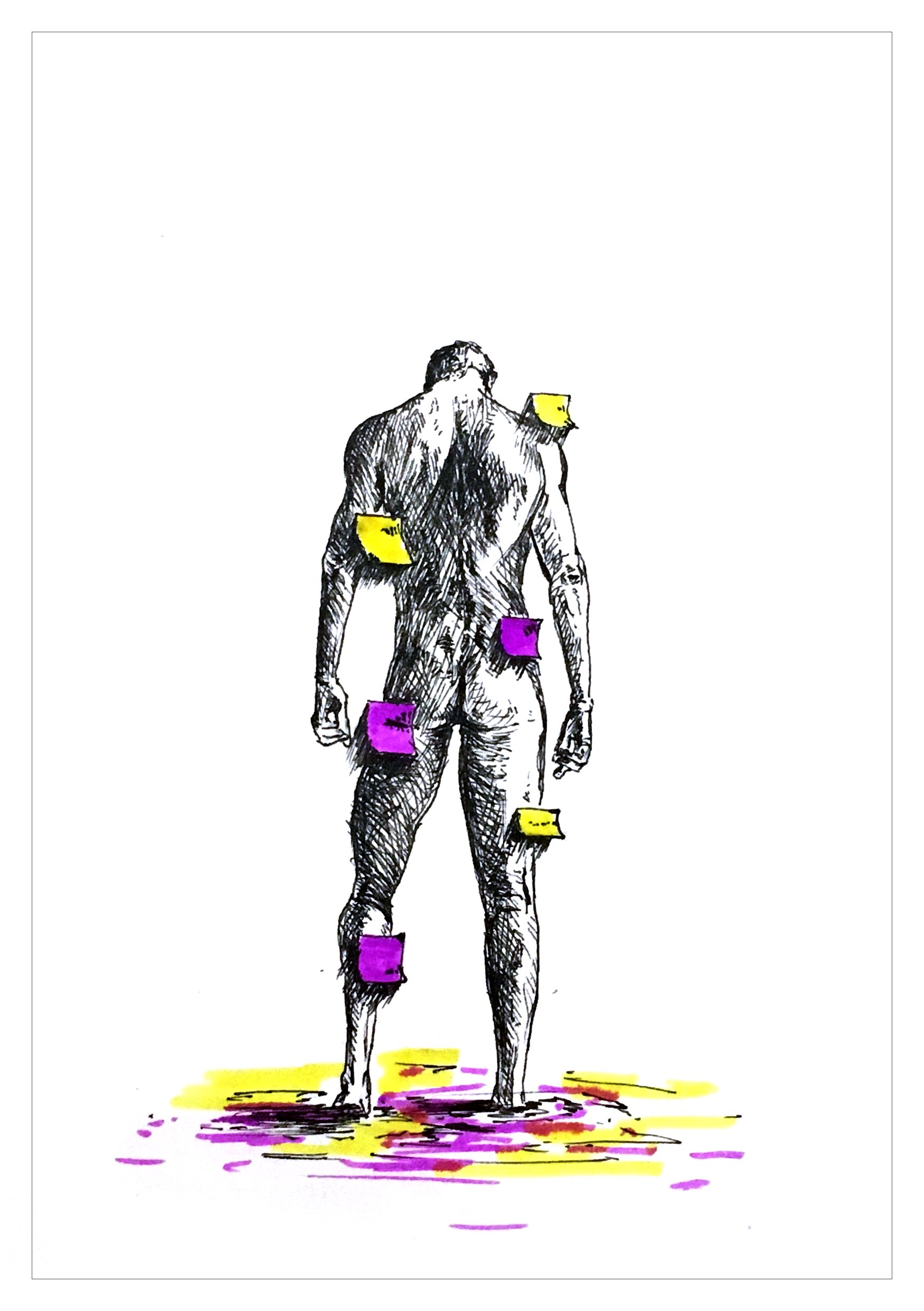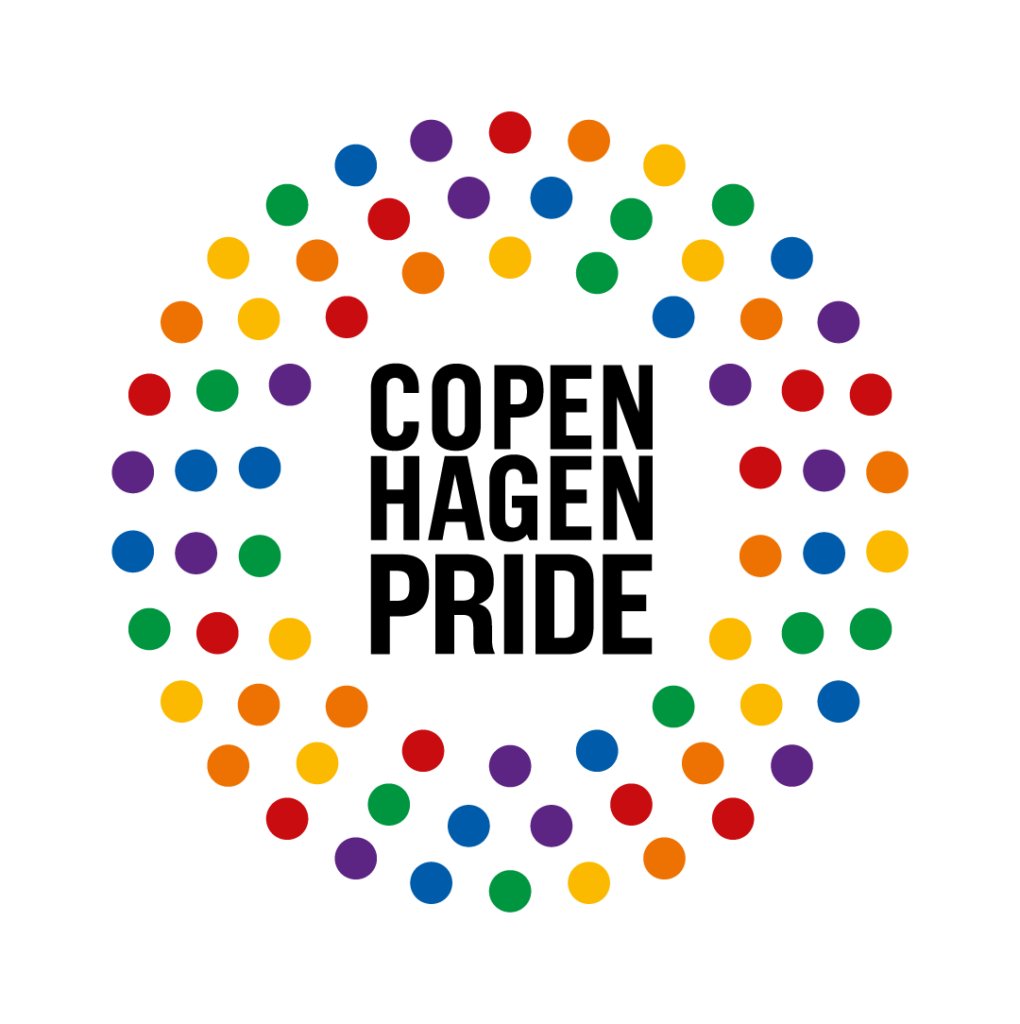
Queer Migrations
Imagining Intersectional Positions and Potentials
By Rieke Schröder og Marie Lunau
Illustration by Meraj Sharifi
The migration of queer people is not a new phenomenon; queer people have sought for safer and more inclusive spaces for centuries; queer people have fled discrimination within borders, from rural to urban, and across borders to seek protection. What is more recent in queer migration is the formation of sexuality and gender identity-based persecution as a legitimate ground for asylum. In Denmark, queer people may be granted asylum if they can successfully prove that they are queer, and that they have a ‘well-founded fear of persecution’ based on their queerness (The Danish Immigration Service, 2021). The Danish organisation LGBT Asylum has documented queer asylum seekers’ difficulties of translating their identities into the kinds of narratives that are ‘legitimate’ within the state’s frame of recognition. As a result, many queer asylum seekers are denied protection because they do not effectively live up to the expected categories of what is understood to be a ‘legitimate’ queer refugee (LGBT Asylum, 2022).
We, the authors of this article, are both PhD students who are engaged in research around and with queer asylum seekers and refugees. Through our research, we seek to challenge the question of ‘who the ‘legitimate’ queer refugee is?’ by exploring intersectional lived and bodily experiences of queer migration. In the context of Danish borderlands, we encounter numerous bordered categories through which queer refugees are separated into distinct and simplified classifications.
Many queer asylum seekers are denied protection because they do not effectively live up to the expected categories of what is understood to be a ‘legitimate’ queer refugee
We have often been confronted with people’s imaginaries about who migrating queers are when we have ‘come out’ as researchers. For Rieke, it has most often been assumed that queer refugees are predominantly coming from Muslim countries, who seek refuge in the ‘tolerant free West’ from their ‘intolerant’ countries of origins. For Marie, it became evident that people imagine the queer refugee to be a cis gay man. Here, our own position as white, European, queer identifying cis women also influences what kind of imaginaries people are comfortable in narrating to us. In this brief piece we attempt to reconstruct, muddle and complicate normalised imaginaries of the queer refugee. In thinking through how the figure of the queer refugee often includes a set of presumptions about who they are, why they are migrating, and what they ‘want’ through their migrations, we intend to tell a different story.
‘A real gay love story’
In what follows, we invite you to read with us through an example from our research encounter with El, a queer refugee, who counteracts and resists simplistic categorisations by pointing us towards their ambivalent and intersectional experiences. We take inspiration from the term intersectionality (Crenshaw, 1989) and the theorist Cathy Cohen who emphasises the interconnections between categories and advocates for a ‘broadened understanding of queerness […] based on an intersectional analysis that recognizes how numerous systems of oppression interact to regulate and police the lives of most people.’ (1997:441). When talking about sexuality and gender identity, El uses the words ‘gay’ and ‘queer’ for themselves. El describes having ‘a man’s body’ but feeling like a girl. The labels ‘trans’ and ‘non-binary’ are rejected by El, who uses all pronouns. How would we categorise El? Is El a cis gay man since El rejects the label trans? We do not think that would be a careful or accurate description. Maybe the struggle here is not to find the right label, but rather to complicate the Eurocentric and colonial expectation that we should be able to label and categorise who we meet and interview.
El’s motivation to come to Europe was to have ‘a real gay love story’. Queer life in Denmark is mostly described in positive terms by El. But even though El describes Denmark as a place where people can be themselves, El simultaneously narrates struggles in trying to date, feeling that others are afraid to date them. Due to overt racism and femmephobia on dating apps and in queer/gay clubs in Copenhagen, El even stopped going to certain places. Here, Nira Yuval-Davis’ (2015) concept of ‘situated intersectionality’ can be helpful to explore how intersecting ‘identity markers’ signify different things in different places. El describes being more open about their sexuality and gender identity in Denmark than in their country of origin. On the other hand, there are specific spaces in Denmark where El’s race, intersecting with El’s queerness, position them differently.
El’s refugee experience has also resulted in limited access to education and jobs in Denmark. El opposes this stagnant position they have been placed within by saying that if they had not migrated to Denmark, they would have likely already completed their bachelor’s and master’s degrees, and perhaps be pursuing their PhD, too. El also points out that if they could turn back time, they would not have come to Denmark in the first place. El pushes us to reconsider the way we tend to think and talk about queerness in the West, and the reasons we assume that make people migrate. In El’s case, they came to Denmark for love, but the hope of queer love has been shattered through the realities of racism, trans- and homophobia in Denmark. By sharing El’s story and the intersectionalities that shape and position queer refugees’ differently, we hope to contribute to thinking about how we can revisit and reconsider the certainties of categories by imagining categories as fluid, changing and as shaped by other categories.
One story of many
In research it has been stressed that queer refugees are not a homogenous group (e.g., Held, 2019). The queer refugees we have met while doing our research are also diverse within the queer umbrella. They are lesbian, gay, bisexual, trans, queer, intersex, non-binary, gender nonconforming, and they frequently identify with more than one of these categories. These different ‘identity markers’ position queer people differently – also in Denmark, where intersex protection is non-existent (Rainbow Europe, n.d.) and trans and non-binary people are experiencing higher rates of hate crimes than cis people (Greve et al., 2022). We have also met queer people through our research who are seeking refuge from European, Asian, African, and American countries. Thus, the imaginative cis gay refugee from a Muslim country is represented within the group of people we have met but is by far not the only queer refugee. The heterogeneity that characterizes the queer refugees we have met is important to centre when thinking through how their different ‘identity markers’ intersect as these will position them differently within society and allow for different accesses to power. Intersectionality (as an orientation, theory, or methodology) is therefore a helpful tool within our work. If we believe the tale of a single story about ‘the queer refugee’, we run the risk of simplifying and obscuring lived realities. Realities that inform and have legal and personal consequences for the way in which queer refugees are being assessed and recognised within the state’s frame of inclusion.
The imaginative cis gay refugee from a Muslim country is represented within the group of people we have met, but is by far not the only queer refugee
Rather, we advocate for a critical reflection of the entangled positions and aspirations of queer refugees that does not rely on fixed, Eurocentric categories, but one that defines queer refugees’ subjectivities through their multifaceted positions.
In returning to our initial quest to challenge normalised and simplified definitions of ‘who the ‘legitimate’ queer refugee is?’, we have described El’s experience as an example of how queer refugees refuse to be categorised and governed as such. In describing queer refugees’ structural, affective, and personal intersections, we have made an attempt to reconstruct preconceived imaginaries of who we think about when we think of queer refugees. Through attentiveness towards queer refugees’ intersecting categories of sexuality, gender, persecution, education, and class, we stand with El’s refusal against what is being imposed on them. Through this piece, we have asked what it would mean to remake the imaginative figure of the queer refugee in order to transcend the reductive modes of representations we see around us. The imaginaries we form through political and everyday discourses on questions of queerness and migration also frame the politics of inclusion and exclusion in contemporary immigration policies. It is therefore pivotal to imagine a radical repositioning of queer refugees’ intersectional positions and experiences in order to expand our imaginations of the ‘legitimate’ queer refugee.
Learn more during Winter Pride Week:
Monday 20 February
18.30-19.30
Crash Course in intersectionality
Language: English
Venue: Musikcaféen
Tuesday 21 February
18.30-19.30
Intersections
Language: Danish
Venue: Musikcaféen
18.30-19.30
Workshop: Anti-racist work
Language: English
Venue: Balsalen
Friday 24 February
15.00-01.00
LGBT Asylum Anniversary Party & Book Launch
Location: Union, Nørre Allé 7, 2200 København N
References
Cohen, C. J. (1997). ‘Punks, Bulldaggers, and Welfare Queens: The Radical Potential of Queer Politics?’ GLQ: A Journal of Lesbian and Gay Studies, 3(4), Article 4. https://doi.org/10.1215/10642684-3-4-437
Crenshaw, K. (1989). De-marginalizing the intersection of race and sex: A black feminist critique of antidiscrimination doctrine, feminist theory and antiracist politics. The University of Chicago Legal Forum, 140, 139-167
Held, N. (2019) ‘Sexual Orientation and Gender Identity. Claims of Asylum in Germany: Intersectional Legal, Social and Methodological Challenges’, in C. Küppers and Bundesstiftung Magnus Hirschfeld (eds) Refugees & Queers. transcript-Verlag, pp. 53–80. Available at: https://doi.org/10.14361/9783839442111-004.
Greve, J. Østergaard, S. V., Andersen, M. and Thomsen, M.K. (2022). Kortlægning af homo- og biseksuelles samt trans- personers levevilkår og samfundsdeltagelse. VIVE. Available at: https://lgbt.dk/wp-content/uploads/2022/08/VIVE-2022-Kortlaegning-af-homo-og-biseksuelles-samt-transpersoners-levevilkar-og-samfundsdeltagelse.pdf (accessed 24.11.2022)
LGBT Asylum. (2022). Årsberetning 2021. LGBT Asylum. Available at: https://lgbtasylum.dk/website/wp-content/uploads/2022/10/LGBT-Asylum-Aarsberetning-2021-WEB.pdf [accessed 21.11.2022]
Rainbow Europe (n.d.) ‘Rainbow Map’, Available at: Rainbow Europe (rainbow-europe.org)(Accessed 16.11.2022)
The Danish Immigration Service. (2021). “What are the requirements for being granted asylum?” Available at: https://www.nyidanmark.dk/en-GB/You-want-to-apply/Asyl/Voksen-asylansøger(accessed 21.11.2022)
Yuval-Davis, N. (2015) ‘Situated Intersectionality and Social Inequality’, Raisons politiques, 58(2), pp. 91–100. Available at: https://doi.org/10.3917/rai.058.0091.



